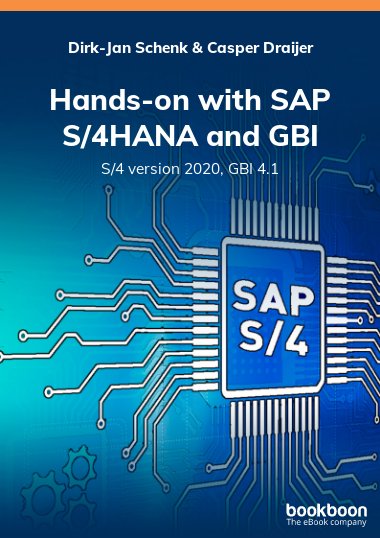- Preface
- Introduction
- Study Guide
- PART 1 Enterprise Resource Planning and SAP
- Enterprise Resource Planning
- Enterprise Resource Planning Software
- Enterprise Resource Planning as a Follow-Up to MRP
- Advantages and Disadvantages of ERP
- Functions of Enterprise Resource Planning
- Supply Chain Management
- Supply Chain Management and Enterprise Resource Planning
- The Company: SAP AG
- The Company: SAP AG
- Products of SAP AG
- SAP S/4HANA
- Structure of SAP S/4HANA
- Analytics
- Financials
- Human Capital Management
- Procurement and Logistics Execution
- Product Development and Manufacturing
- Sales and Service
- Corporate Services
- Organization Depicted in SAP S/4HANA
- Sorts of Data
- Organization Structure Projected in SAP S/4HANA
- Projecting the Business Structure in SAP S/4HANA
- SAP Hierarchy
- Financial (FI)
- Material Management (MM)
- Sales and Distribution (SD)
- Customizing
- Scope of the Implementation
- The Approach to the Project
- Confusing Terminology
- Customizing
- Intelligent Enterprise
- Intelligent Enterprise
- Collaborative Business
- GBI
- Short Description of GBI
- PART 2 Carrying out a Complete ERP Process
- Log on and the SAP S/4HANA Interface
- Accounts Receivable
- Customer Balance
- Customer Master Data
- General Ledger Administration
- General Ledger Account Master Data
- Balance Sheet and Profit and Loss Statement
- Accounts Payable
- Invoice Processing C-Business Diagram
- Vendor Master Data
- Post the Invoice
- Monitoring the Accounts Payable
- Payment to a Vendor
- Human Resources
- Position
- Hiring a New Employee
- Logistic Master Data
- Master Data for the Materials
- Bill of Material
- Direct Wage Hours and Machine Hours
- Work Center
- Routing
- Production Version
- Info Record
- Complete ERP Process
- General
- C-Business Logistics Diagram
- Create a Quotation for a Customer
- Create a Customer Order
- The Stock/Requirements List
- Requirements Planning (MRP)
- Create a Purchase Order for the Supplier
- Goods Receipt from a Supplier
- Transfer Order Goods Receipt to Permanent Storage
- Receipt of the Invoice from the Supplier
- Payment of the Supplier’s Invoice
- Production Order
- Issue of Raw Materials to Production
- Transfer Raw Materials to Production
- Confirmation of a Production Order
- Goods Receipt Finished Product from Production
- Creating a Delivery to the Customer
- The Document Flow Around the Sales Order
- Picking the Delivery
- Goods Issue Delivery to the Customer
- Invoice the Customer
- Incoming Payment from the Customer
- Tracking and Tracing
- PART 3 Special Applications
- Fixed Assets
- C Business Diagram Acquisition of Fixed Assets Scenario
- Create Fixed Asset
- Registering the Purchase
- Payment of the Supplier’s Invoice
- 360 View on Asset
- Depreciation
- Repair Order
- C-Business Diagram Internal Order Processing
- Equipment Master Data
- Create Malfunction Report
- Info Record
- Create Maintenance Order
- Release Maintenance Order
- Ordering Materials for Internal Use
- Goods Receipt from a Supplier
- Receipt of the Invoice from the Supplier
- Payment of the Supplier’s Invoice
- Overall Completion Confirmation
- Analyse Cost and Technical Completion
- Settlement of Costs of the Maintenance Order
- Analyse the Costs Business Completion
- Display Order History
- Production on Stock and Forecast Based Planning
- Production on Stock and Forecast Based Planning
- Master Data Change and Extension
- Product Group
- Demand Management
- Forecast Based Planning
- Production Planning
- Create a Purchase Order for the Supplier
- Goods Receipt from a Supplier
- Transfer Order Goods Receipt to Permanent Storage
- Receipt of the Invoice from the Supplier
- Payment of the Supplier’s Invoice
- Production Order
- Issue of Raw Materials to Production
- Transfer Raw Materials to Production
- Confirmation of a Production Order
- Goods Receipt Finished Product from Production
- Sales from Stock
- Creating a Delivery to the Customer
- The Document Flow Around the Sales Order
- Picking the Delivery
- Goods Issue Delivery to the Customer
- Invoice the Customer
- Incoming Payment from the Customer
- Analyses
- Product Costing
- Cost of Goods Manufactured
- Change Master Data and Bom
- Cost of Goods with Overhead
- Stock Valuation at Costs of Goods Manufactured
- Production Order Using Product Costing
- Requiremetns Planning (MRP)
- Create a Purchase Order for the Supplier
- Goods Receipt from a Supplier
- Transfer Order Goods Receipt to Permanent Storage
- Receipt of the Invoice from the Supplier
- Payment of the Supplier’s Invoice
- Production Order Release
- Issue of Raw Materials to Production
- Transfer Raw Materials to Production
- Confirmation of a Production Order
- Goods Receipt Finished Product from Production
- Planned and Actual Costs Production Order
- Actual Overhead
- Variance Analysis Production
- Settlement of Production Order
- Overview of Planned and Actual Cost Production Order

